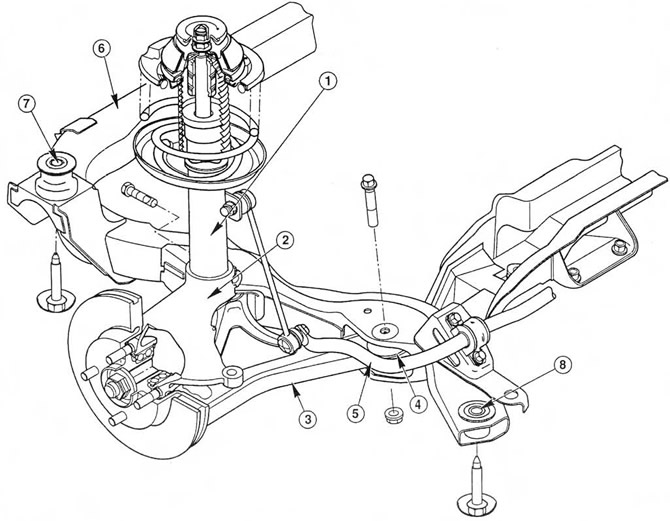 Pic. 1.1. Front suspension components.
Pic. 1.1. Front suspension components.
1. MacPherson strut
2. Knuckle
3. Lower arm
4. Bushing of the vertical silent block on the lower arm
5. Stabilizer bar
6. Front subframe
7. Front subframe rubber bushing
8. Rear subframe rubber bushing
2. Sedan and Hatchback models are equipped with a rear independent suspension type "Quad-raliink" with four support points on each side of the vehicle. Her two lower arms (on each side of the car) the outer ends are connected to the support of the rear suspension axle, and the inner ends - to the beam. Reaction arm (on each side of the car), fixed on the lower part of the fist and the floor, perceives the forces that occur during braking and acceleration (see fig. 1.2).
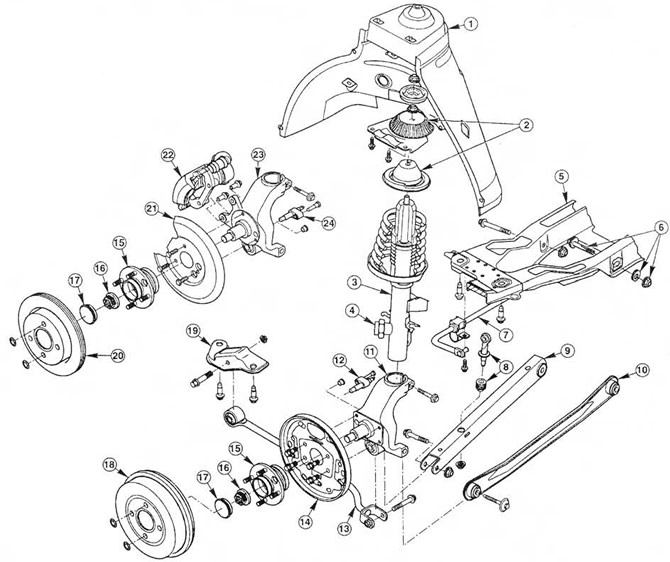 Pic. 1.2. Rear suspension components - Sedan and Hatchback models.
Pic. 1.2. Rear suspension components - Sedan and Hatchback models.
1. Wheel arch
2. Upper support bracket and coil spring seat
3. Rack
4. Solenoid valve for adaptive suspension
5. Rear suspension beam
6. Eccentric bolt for rear wheel alignment
7. Stabilizer bar
8. Connecting link
9. Front lower arm
10. Rear lower arm
11. Rear axle support (models with drum brakes)
12. ABS wheel sensor
13. Reaction arm
14. Back shield
15. Hub assembly with bearings
16. Hub nut
17. Cap with grease
18. Brake drum
19. Reaction arm support bracket
20. Brake disc
21. Mudguard (models with disc brakes)
22. Brake caliper (models with disc brakes)
23. Rear axle support (models with disc brakes)
24. ABS wheel sensor (models with disc brakes)
3. On the Station wagon models, a rear independent suspension of the type "SLA" (short-long arm). It provides a large area of the luggage compartment, since there are no parts of the suspension protruding into it. The suspension has three wishbones on each side. The top arm is forged and the two lower arms are stamped. Reaction arm (from each side) supports the rear axle support. Coil springs mounted separately from shock absorbers (see fig. 1.3).
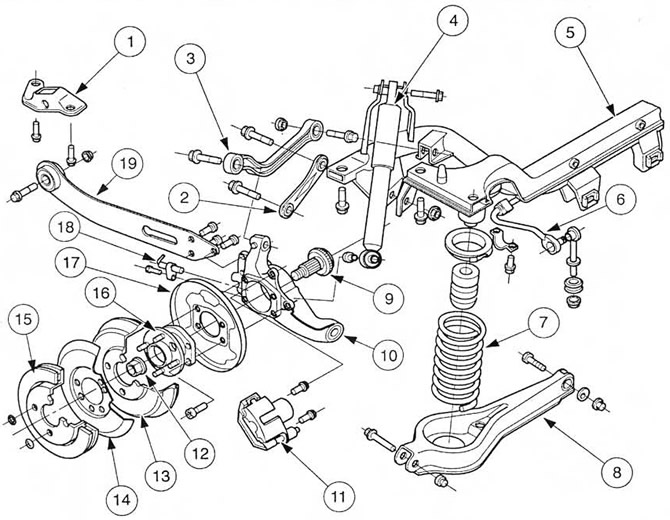 Pic. 1.3. Rear suspension components - Estate models.
Pic. 1.3. Rear suspension components - Estate models.
1. Reaction arm support bracket
2. Short front lower arm
3. Short front upper arm
4. Shock absorber
5. Beam
6. Stabilizer bar
7. Helical spring
8. Rear lower arm
9. Pin (included in the hub assembly with bearings)
10. Rear axle support
11. Brake caliper (models with disc brakes)
12. Hub nut
13. Brake drum
14. Mudguard (models with disc brakes)
15. Brake disc
16. Hub assembly with bearings
17. Back shield (models with drum brakes)
18. ABS wheel sensor
19. Reaction arm
4. An anti-roll bar is installed on all models. On SI models, the front and rear shock absorbers are gas. Other models have hydraulic shock absorbers. On GHIA-Estate models (station wagon) rear shock absorbers with automatic suspension height adjustment are installed as standard equipment.
5. Steering rack and pinion gear with variable gear ratio. The telescopic steering column contains two cardan joints. All models are fitted with power steering. The steering hydraulic system radiator is installed in front of the engine cooling system radiator on the beam. On adaptive suspension models, the steering position sensor and its disc are mounted above the upper universal joint.
6. On models with adaptive suspension, you can choose "hard" or "soft" modes for the front and rear shock absorbers. The adaptive suspension system is controlled by a computer. Using the switch located next to the handbrake lever, you can select the mode "sport" or "normal". In such a suspension, a solenoid valve is installed on each rack. When the valve is open, fluid flows through a bypass circuit inside the shock absorber. Due to this, a soft mode is implemented. When the valve is closed, the damper becomes stiffer. The system reacts to the speed of the vehicle. At high speeds, the damper automatically becomes stiffer. The computer that controls the adaptive suspension is installed in the luggage compartment behind the rear seats. It has a self-diagnosis function (see fig. 1.6, a, b). The adaptive suspension is not installed on the Wagon model.
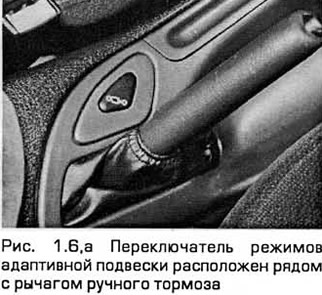
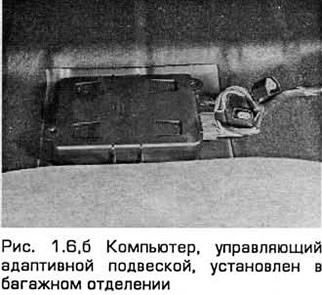
7. When servicing the suspension or steering, you may come across bolts or nuts that are difficult to remove. They are located on the bottom, and therefore they are constantly exposed to water, dirt, etc., as a result of which they rust. To unscrew the fasteners without much difficulty, lubricate them with penetrating oil. wait a while and then turn away.
8. It is also useful to clean the threads with a wire brush. You can unscrew the nut with a hammer and a core. When doing this, be careful not to damage the threads. Sometimes, to loosen a nut or bolt, it is useful to heat them and the surrounding parts with a soldering pump. However, this is not recommended due to the risk of fire. For unscrewing, you can also use the rods and nozzles as levers. Most of the operations presented in this chapter require the vehicle to be raised and supported. When lifting the car, instead of a standard jack from the tool kit, it is better to use a mobile hydraulic jack. It can also be used to support individual components during removal and installation operations.
Warning: Never work under a vehicle supported only by a jack. Do not raise the machine by jacking up the front or rear subframes.
Visitor comments